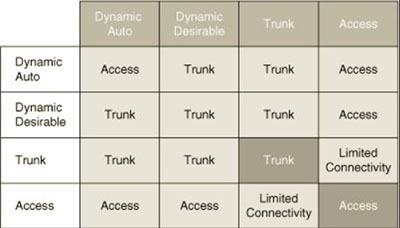VLAN & Trunking Questions 2
Question 1
Explanation
Layer 2 switches do not change MAC address so PC_A will put PC_B MAC address into its destination address before sending it to the switch. PC_B will receive the frames with the source and destination MAC address intact.
Note: Only with routers, including layer-3 switches where the packets need to cross to other VLANs, will the frames be stripped and rewritten for the new network or VLAN.
Question 2
Explanation
In fact we only need to add (allow) VLAN 13 to the trunk link of Switch A. Switch B allows all VLANs by default so we don’t need to do any further configuration.
Question 3
Explanation
If the neighboring switch is set to trunk then we need to set our switch to desirable mode so that it can start the negotiation. In fact answer C is also correct according to the table below:

But “desirable” mode is a safer answer so we should choose it.
Question 4
An engineer requires a switch interface to actively attempt to establish a trunk link with a neighbor switch. What command must be configured?
A. switchport mode trunk
B. switchport mode dynamic desirable
C. switchport mode dynamic auto
D. switchport nonegotiate
Answer: B
Question 5
An engineer must configure interswitch VLAN communication between a Cisco switch and a third-party switch. Which action should be taken?
A. configure IEEE 802.1p
B. configure IEEE 802.1q
C. configure ISL
D. configure DSCP
Answer: B
Explanation
IEEE 802.1Q is the networking standard that supports virtual LANs (VLANs) on an Ethernet network. When a frame enters the VLAN-aware portion of the network (a trunk link, for example), a VLAN ID tag is added to represent the VLAN membership of that frame. The picture below shows how VLAN tag is added and removed while going through the network.




Hi @9tut,
Shouldn’t the answer to question 3 be B) “configure switchport mode dynamic desirable”?
Wouldn’t this cause a trunk link to be established between the two switches as the 1st switch is set to trunk or desirable mode?
@Question 3: Yes, thanks for your detection, we have just updated it!
So what would be the correct answer to question 3. If it is not the letter B, immediately informed in the comments above, then what would it be?
For me the right answer is to question 3 is “mode dynamic auto”. From Ciscopress:”switchport mode dynamic auto: Makes the interface able to convert the link to a trunk link. The interface becomes a trunk interface if the neighboring interface is set to trunk or desirable mode.”
But the right answers for Q3 are both B and C
Q3- answer is both B and C. 9tut, could you please share your opinion? :)
Q3 – I also believe answer is B. Question states that the neighbor switch is set to trunk OR desirable. If it is set to trunk, then other switch must be set to desirable so that it actively sends messages to negotiate the trunk. If it is set to auto, it will only respond to messages to negotiate the trunk.
I’m here to learn too, so please correct me if I am wrong.
@9tut, Is Q3 correct?
Q3 is correct with establishing the two switches.
if the switch is set to either trunk or desirable mode. then the safer more “secure” option out of these would be
B: configure switchport mode dynamic desirable.
it is true that ‘auto’ can be correct according to table but B would be the better option.
why Q1 i think is incorrect
LMAO at question 5 explanation. LOL what?
The questions don’t seem to appear anymore, only the answers. Anyone else have this problem?